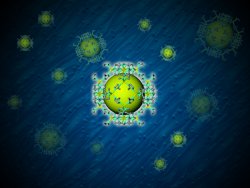Physical Sciences Division
Research Highlights
May 2010
Creating a Captivating Cage for Carbon
New robust material could selectively trap energy-diluting impurities in natural gas
 A tough, hard-working particle known as ZIF-8 that can selectively remove carbon dioxide from a complex mixture of gases was designed by scientists at Pacific Northwest National Laboratory. Enlarge Image
A tough, hard-working particle known as ZIF-8 that can selectively remove carbon dioxide from a complex mixture of gases was designed by scientists at Pacific Northwest National Laboratory. Enlarge Image
Results: A tough, hard-working particle known as ZIF-8 that can selectively remove carbon dioxide from a complex mixture of gases was designed by scientists at Pacific Northwest National Laboratory. Similar materials available today are very delicate, unable to tolerate exposure to water and air. The hexagonal crystals are far from delicate, but the crystals were designed using a straightforward approach that relies on three readily available chemicals.
Why it matters: Natural gas often contains carbon dioxide and other impurities that reduce the effectiveness of this common fuel. Industries need a material to remove the carbon dioxide. The ideal material is affordable, selective, removes large amounts of carbon dioxide, and can be recharged. A rechargeable material traps its target and then releases it under specific circumstances. Rechargeable materials can be used repeatedly, reducing costs and waste. Nano ZIF-8 might prove to be the answer.
Methods: Working with the chemicals at about 100 degrees centigrade, the temperature at which water boils, the researchers melted off-the-shelf zinc nitrate and 2-methyl imidazole with a third chemical known as a surfactant, which helped the chemicals to mix to form hexagonal shaped crystals. They washed out the impurities and dried the crystals. The surfactant in the mixture caused the chemicals to assemble into nanoscale ZIF-8, a white powder resembling baking flour.
Next, the team did extensive experiments on the particles with transmission electron microscopes, scanning electron microscopes, and electron tomography at the Department of Energy's EMSL. They found that the crystals had a diameter of about 50 nanometers with a wall thickness of about 40 nanometers and very high surface area. "A gram of this stuff has the area of a football field," said Dr. Praveen Thallapally, a materials scientist at PNNL and co-lead on this research with Dr. Jun Liu and Dr. Greg Exarhos.
What's next: Funded by DOE's Office of Basic Energy Sciences, the team will be conducting research to increase the surface area of the material. While the material has a high surface area, it is about a factor of 3 lower than the more common material available today. "We want to increase that surface area, to really push the envelope," said Exarhos.
Acknowledgments: DOE's Office of Basic Energy Sciences funded this study by the interdisciplinary team of Satish Nune, Praveen Thallapally, Alice Dohnalkova, Chongmin Wang, Jun Liu, and Greg Exarhos of PNNL. Key work was done in DOE's EMSL, a national scientific user facility.
Reference: Nune SK, PK Thallapally, A Dohnalkova, C Wang, J Liu, and GJ Exarhos. 2010. "Synthesis and Properties of Nano Zeolitic Imidazolate Frameworks." Chemical Communications 46:4878-4880. DOI:10.1039/c002088e. This research appeared on the journal’s cover.
